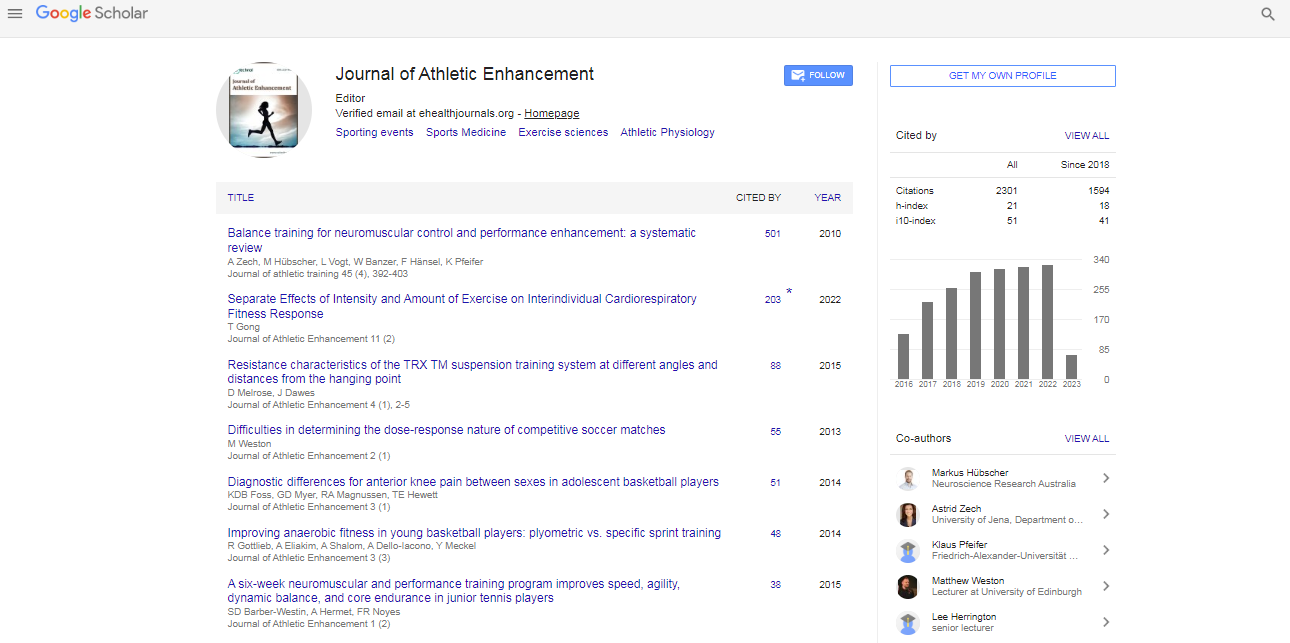Opinion Article, J Athl Enhanc Vol: 12 Issue: 6
The Science behind Athletic Training: Techniques and Principles
Sara Bonk*
1Department of Physical Education, University of Toronto, Toronto, Canada
*Corresponding Author: Sara Bonk,
Department of Physical Education, University
of Toronto, Toronto, Canada
E-mail: bonksa_ra@utoronto.ca
Received date: 30 October, 2023, Manuscript No. JAE-24-124076;
Editor assigned date: 02 November, 2023, PreQC No. JAE-24-124076 (PQ);
Reviewed date: 16 November, 2023, QC No. JAE-24-124076;
Revised date: 23 November, 2023, Manuscript No. JAE-24-124076 (R);
Published date: 30 November, 2023 DOI: 10.4172/2324-9080.100088
Citation: Bonk S (2023) The Science behind Athletic Training: Techniques and Principles. J Athl Enhanc 12:6.
Description
Athletic training is a multifaceted discipline that encompasses the prevention, assessment, management, and rehabilitation of injuries and medical conditions related to physical activity and sports. It's a crucial component of the sports and healthcare industry, playing a pivotal role in enhancing athletic performance, minimizing injuries, and promoting overall well-being among athletes.
The roots of athletic training can be traced back to ancient civilizations where rudimentary methods were employed to treat injuries sustained in sports and battles. However, the formalization of athletic training as a profession began in the late 19th century, primarily in response to the rising interest in sports and the need for proper care of athletes. The establishment of the National Athletic Trainers' Association (NATA) in 1950 in the United States marked a significant milestone in the professionalization and standardization of athletic training.
Athletic trainers are healthcare professionals specializing in preventing, diagnosing, treating, and rehabilitating injuries related to physical activity. They work closely with athletes, coaches, physicians, and other healthcare professionals to ensure the well-being and optimal performance of athletes. Their responsibilities include:
Injury prevention
• Designing and implementing injury prevention programs tailored to specific sports or activities.
• Educating athletes about proper warm-up techniques, equipment use, and injury risk reduction strategies.
Immediate care
• Providing immediate care and first aid in case of injuries during practices or competitions.
• Evaluating and stabilizing injuries until further medical assistance is available.
Rehabilitation
• Creating personalized rehabilitation programs to facilitate the recovery of injured athletes.
• Supervising exercises and therapies to restore strength, flexibility, and function.
Health and wellness promotion
• Educating athletes about nutrition, hydration, rest, and lifestyle choices to optimize performance and overall health.
• Collaborating with other healthcare professionals to address mental health concerns and promote holistic well-being.
Becoming an athletic trainer typically requires a bachelor's or master's degree in athletic training from an accredited program. These programs cover various subjects such as anatomy, physiology, biomechanics, therapeutic modalities, and injury assessment. Additionally, aspiring athletic trainers must pass the Board of Certification (BOC) exam to become certified and meet state-specific licensing requirements, which may include continuing education to maintain certification.
Advancements in technology have significantly impacted athletic training. Tools like motion analysis systems, wearable devices, and telemedicine have revolutionized injury assessment, performance tracking, and remote monitoring of athletes. These innovations enable trainers to gather precise data, analyze movement patterns, and tailor training regimens to individual needs.
Athletic training faces challenges such as balancing the demands of sports with injury prevention, navigating evolving healthcare policies, and addressing the mental health aspects of athletes. Additionally, the need to adapt to new sports and exercise trends, along with the integration of emerging technologies, remains a constant challenge and opportunity for growth within the field.
Looking ahead, the future of athletic training is likely to involve a deeper integration of data-driven approaches, expanded emphasis on mental health support, and increased collaboration among various healthcare disciplines to provide comprehensive care for athletes.
Athletic training is an indispensable part of the sports landscape; ensuring athletes receive optimal care to perform at their best while minimizing the risk of injuries. As the field continues to evolve, athletic trainers will play an increasingly vital role in promoting the health, well-being, and longevity of athletes across various sports and physical activities. Their expertise, dedication, and commitment to the holistic care of athletes contribute significantly to the success and sustainability of the sports industry.
 Spanish
Spanish  Chinese
Chinese  Russian
Russian  German
German  French
French  Japanese
Japanese  Portuguese
Portuguese  Hindi
Hindi 
